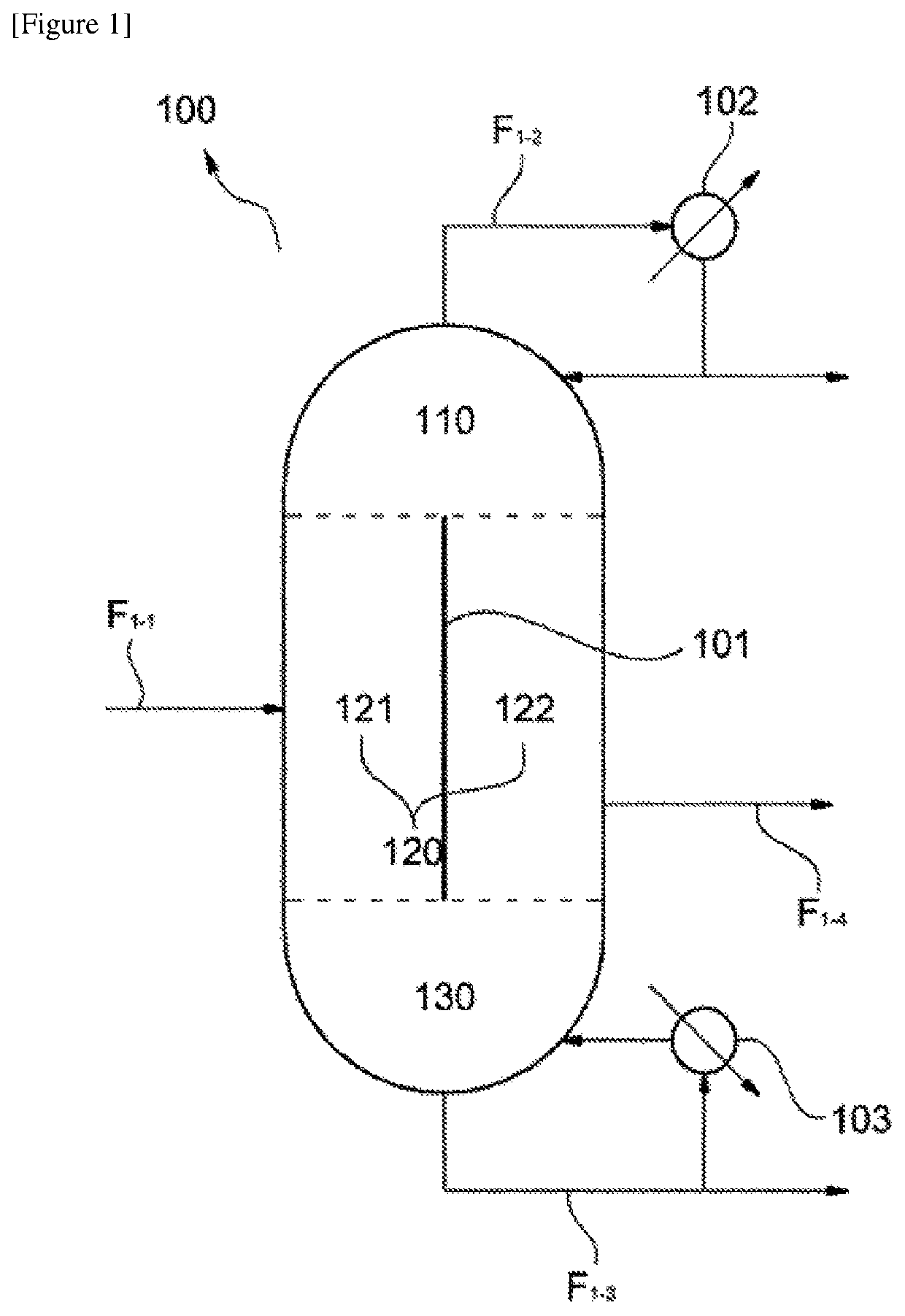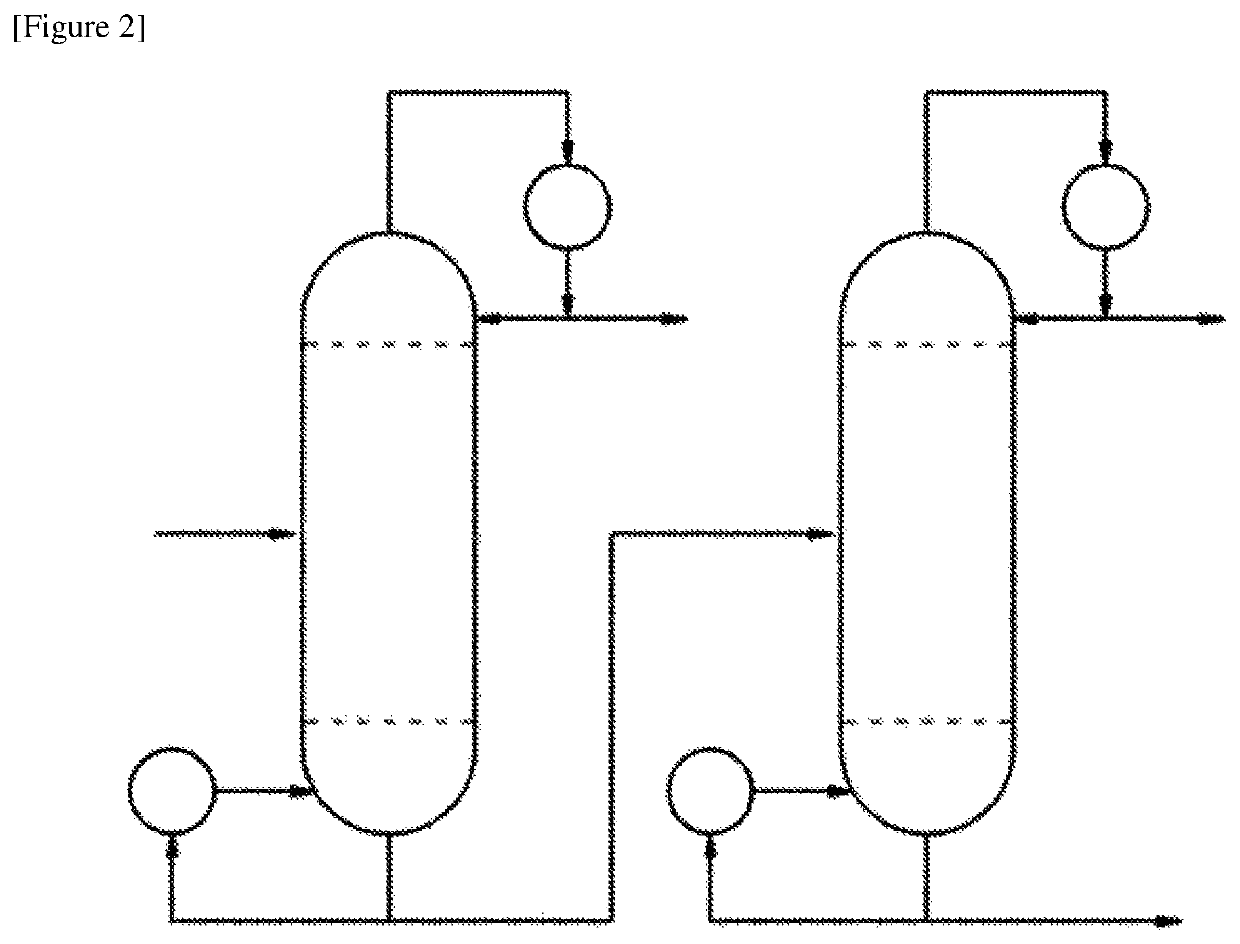Distillation method
a distillation device and distillation method technology, applied in the direction of photomechanical equipment, instruments, separation processes, etc., can solve the problems of high cost of organic solvent among the cost of raw materials, large amount of energy loss, and waste emitted from manufacturing processes, so as to reduce the installation cost of the distillation device, increase the economic feasibility of a process, and reduce the effect of cos
- Summary
- Abstract
- Description
- Claims
- Application Information
AI Technical Summary
Benefits of technology
Problems solved by technology
Method used
Image
Examples
example 2
[0095]A waste stripper solution including a non-aqueous stripper and a stripped photoresist resin was separated in the same manner as in Example 1, except that an operation pressure and operation temperature of the column top zone of the dividing wall column were respectively adjusted to 100 mmHg and 50 to 55° C., an operation pressure and operation temperature of the column bottom zone thereof were respectively adjusted to 160 to 170 mmHg and 175 to 180° C., and an operation pressure and operation temperature of the product discharge zone thereof were respectively adjusted to 130 to 140 mmHg and 120 to 125° C. In this case, a reflux ratio of the column top zone of the dividing wall column was set to 2 to 2.5, a boilup ratio of the column bottom zone was set to 57.2 to 57.5, the content of water in the product stream was 1 ppm, and the content of a high boiling point impurity, a photoresist, in the column bottom stream was 2 ppb.
example 3
[0096]An aqueous stripper including an organic amine compound, a protic glycol ether based organic solvent, an aprotic polar solvent, and water; and a waste stripper solution including a stripped photoresist were separated by means of the distillation device illustrated in FIG. 1. In particular, a 25° C. raw material including 7% by weight of monoethanolamine (MEA), 20% by weight of ethyleneglycol (EG), 45% by weight of diethyleneglycolmonoethylether (EDG), 5% by weight of N-methylpyrrolidone (NMP), 1% by weight of a photoresist, 2% by weight of methanol, and 20% by weight of water was introduced into a feed supply zone of a dividing wall column having a theoretical number of plates of 24 at a flow rate of 1500 kg / hr, thereby performing a separation process. The introduced raw material was discharged through a stream of each of a column top zone, a product sidedraw zone, and a column bottom zone of the dividing wall column.
[0097]Here, a portion of the column top stream discharged fr...
example 4
[0098]A waste stripper solution including an aqueous stripper and a stripped photoresist resin was separated in the same manner as in Example 3, except that an operation pressure and operation temperature of the column top zone of the dividing wall column were respectively adjusted to 100 mmHg and 40 to 45° C., an operation pressure and operation temperature of the column bottom zone thereof were respectively adjusted to 160 to 170 mmHg and 160 to 165° C., and an operation pressure and operation temperature of the product discharge zone thereof were respectively adjusted to 130 to 140 mmHg and 70 to 75° C. In this case, a reflux ratio of the column top zone of the dividing wall column was set to 31 to 31.5, a boilup ratio of the column bottom zone was set to 207 to 207.5, the content of a low boiling point impurity, methanol, in the product stream was 1 ppm, and the content of a high boiling point impurity, a photoresist, in the column bottom stream was less than a measurable limit ...
PUM
| Property | Measurement | Unit |
|---|---|---|
| boiling point | aaaaa | aaaaa |
| temperature | aaaaa | aaaaa |
| temperature | aaaaa | aaaaa |
Abstract
Description
Claims
Application Information
 Login to View More
Login to View More - R&D
- Intellectual Property
- Life Sciences
- Materials
- Tech Scout
- Unparalleled Data Quality
- Higher Quality Content
- 60% Fewer Hallucinations
Browse by: Latest US Patents, China's latest patents, Technical Efficacy Thesaurus, Application Domain, Technology Topic, Popular Technical Reports.
© 2025 PatSnap. All rights reserved.Legal|Privacy policy|Modern Slavery Act Transparency Statement|Sitemap|About US| Contact US: help@patsnap.com


